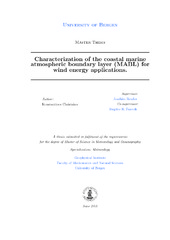Characterization of the coastal marine atmospheric boundary layer (MABL) for wind energy applications
Master thesis
Permanent lenke
https://hdl.handle.net/1956/7186Utgivelsesdato
2013-06-03Metadata
Vis full innførselSamlinger
- Geophysical Institute [1198]
Sammendrag
The main problem for the characterization of marine atmospheric boundary layer is the lack of available offshore measurements in relevant altitude range up to 200 m. Remote sensing meteorological instruments such as LIDARs or SODARS are applied in the field to provide the essential wind profile and turbulence data. The master thesis presents an analysis of 4 years of lidar wind profile measurements at the small island of Storholmen off the Norwegian coast. This site is expected to represent offshore conditions for most of the time. A statistical analysis of different parameters which are related to wind power meteorology, i.e. horizontal and vertical wind speed, turbulence parameters (horizontal and vertical turbulence intensity, and turbulence kinetic energy) and wind shear, is presented. The results show a clear relation between horizontal turbulence intensity distribution and the wind speed. A high correlation between TKE and horizontal turbulence intensity is also observed for high wind speeds. Furthermore, for offshore conditions, the occurrence of high TKE increases. Offshore wind profiles are investigated with respect to turbulence parameters, atmospheric stability and wind shear. The analysis shows a strong relation between turbulence parameters and average wind profiles and wind shear. The results indicate that these turbulence parameters can potential be used as a proxy of the classification of atmospheric stability for offshore conditions in cases of missing temperature profile data. Finally, case studies of different mesoscale phenomena are investigated using a combination of SAR, lidar and met mast data. The results show that this potential combination of instruments can be applied for an improved knowledge of these phenomena and their potential effects on offshore applications.
